Degenerative disc disease (DDD)
- Normal Liver Cells Found to Promote Cancer Metastasis to the Liver
- Nearly 80% Complete Remission: Breakthrough in ADC Anti-Tumor Treatment
- Vaccination Against Common Diseases May Prevent Dementia!
- New Alzheimer’s Disease (AD) Diagnosis and Staging Criteria
- Breakthrough in Alzheimer’s Disease: New Nasal Spray Halts Cognitive Decline by Targeting Toxic Protein
- Can the Tap Water at the Paris Olympics be Drunk Directly?
Degenerative disc disease (DDD)
Degenerative disc disease (DDD). Spine surgery, neurosurgery, rehabilitation, pain and other doctors may have specific definitions of the term degenerative disc disease (DDD), and the wise see the wisdom.
Spine surgery, neurosurgery, rehabilitation, pain and other doctors may have specific definitions of the term degenerative disc disease (DDD), and the wise see the wisdom.
At present, the use of cell or molecular biology techniques (stem cells, proteins, genetic methods, etc.) to treat degenerative disc diseases has achieved good results. But because the specific definition of this term is still controversial, do they treat the same type of disease? Is there a comparison?
Degenerative disc disease as a concept and term has flourished in the past few decades.
At present, it is generally believed that intervertebral disc degeneration is one of the many gradual changes that are mainly caused by the natural aging and aging of the human body. It is certainly not a disease.
However, the process of intervertebral disc degeneration can be rapidly accelerated by other pathogenic factors, such as severe trauma. If this view is generalized to relatively minor physical injury or frequent spine weight bearing (such as occupational and leisure activities), it may lead to another concept, that is, all intervertebral disc degeneration is caused by injury or disease. It is a kind of “disease”.
In addition, since most disc degenerations do not have symptoms, the use of “degenerative disc diseases” (DDD) as a synonym for disc degeneration may be misleading. This wrong usage may contribute to clinical work. For example, when diagnosing non-specific low back pain, in addition to intervertebral disc degeneration, no other lesions can be found, so the low back pain is simply attributed to the degenerated intervertebral disc. Therefore, the acronym DDD has been spoofed as “Diagnostic Deficiency Disease”.
Definition of historical changes
In order to better understand the ins and outs of the term “degenerative disc disease,” Captain Gilblet Fletcher, a Pennsylvania military doctor, studied 600 World War II veterans who had retired due to low back pain in 1947. For the first time, he used “degenerative disc disease ( degenerative disc diseases, DDD)” this term. Even now, the pathological changes of most lumbar spine diseases are still not fully understood.
Based solely on X-rays, Captain Fletcher used some severe imaging findings of lumbar disc degeneration such as intervertebral space stenosis, sclerosis, hyperplastic changes (possibly osteophytes), and “subluxation” of the articular joints to diagnose “degenerative disc disease” “. In the second half of the article, he concluded that the performance of spinal degenerative changes is highly related to posterior lumbar dislocation. It now appears that Captain Fletcher is describing the X-ray imaging findings of degenerative lumbar spondylolisthesis, but he calls it “degenerative disc disease.”
In the next two to three decades, the term “degenerative disc disease” was only mentioned occasionally. When it is used, it usually refers only to patients with symptomatic spinal diseases, and intervertebral discs are considered the source of diseases, such as nerve root damage, low back pain, and disc herniation.
With the growing interest in intervertebral disc degeneration and low back pain in the 1970s, the term “degenerative disc diseases (DDD)” has been used more frequently. However, after 1975, the use of this term was no longer limited to symptomatic disc-related diseases, but began to be used as a synonym for disc degeneration.
In the early dozens of papers, the manifestations of intervertebral disc degeneration were often referred to as “degenerative disc disease”. A typical example is a widely cited paper published in the 1976 American Journal of Bone and Joint Surgery. This article defines the stenosis of the intervertebral space on the lumbar lateral radiograph as intervertebral disc degeneration. The article later called it “degenerative disc disease” and pointed out that this is a cause of low back pain.

Contemporary situation
In the 1980s, the term “degenerative disc diseases (DDD)” was widely used in medical scientific literature, and its usage increased exponentially in the following time.
Sometimes, the term refers to painful lumbar disorders that are suspected or known to be related to intervertebral discs. However, the term “degenerative disc diseases (DDD)” has also gradually become a commonly used term for degeneration of the intervertebral disc. Unfortunately, the particularity that it originally referred to painful diseases related to the intervertebral disc has disappeared. exist.
What’s more, in some large-scale epidemiological studies of intervertebral disc degeneration based on the general population, peaches are used instead of plums, and the term “degenerative disc diseases (DDD)” is used instead of “intervertebral disc degeneration”. , Undoubtedly aggravated this chaotic situation.
Inaccurate case definitions and two very different terms used interchangeably are common in epidemiological literature, such as intervertebral disc degeneration, disc degenerative disease, and low back pain, so they will continue to confuse the scientific interpretation of current research.
The use of clearer definitions and more unified terminology will help accurate communication of medical research, avoid unnecessary confusion, and facilitate the horizontal comparison between different studies.
The degeneration of the intervertebral disc itself lacks a standard definition. It is particularly important to clarify the concepts and terms.
Latest discovery
Recently (2019), Professor Battié from Canada and others published in Spine Rights
A review in the Granville magazine SPINE conducted a detailed study and analysis on the specific definition of the term “Degenerative Disc Diseases”.
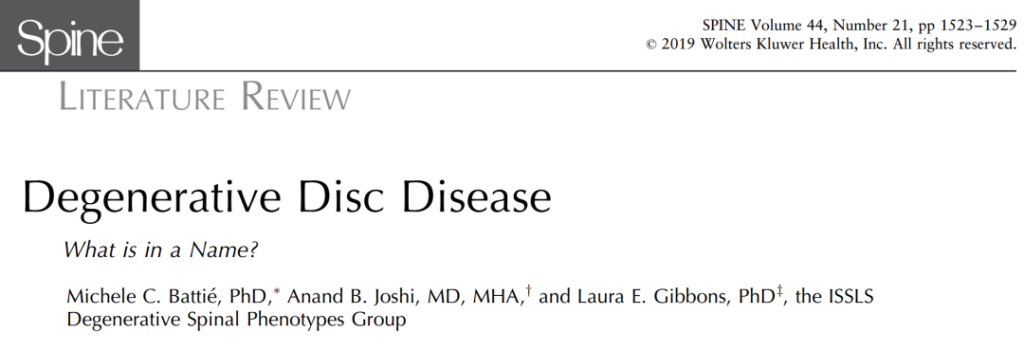
They believe that the definition of degenerative disc disease is “Degenerative disc disease has long been a dominant concept in common, painful spinal disorders”
They searched through Ovid MEDLINE, Embase, CINAHL and Scopus databases, using “degenerative dis* diseas*” as the article title keyword, and the time limit was 2007-2016. It was found that a total of 402 published articles contained Degenerative Disc Disease in the title.
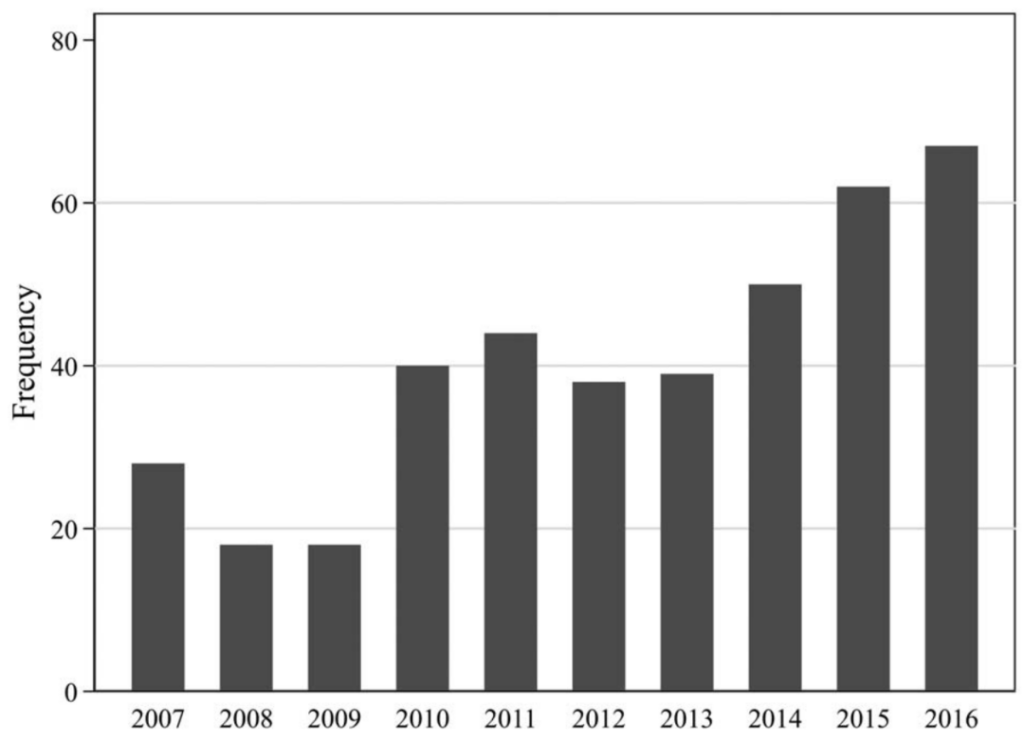
Table: From 2007 to 2016, the annual number of articles published with Degenerative disc disease in the title.
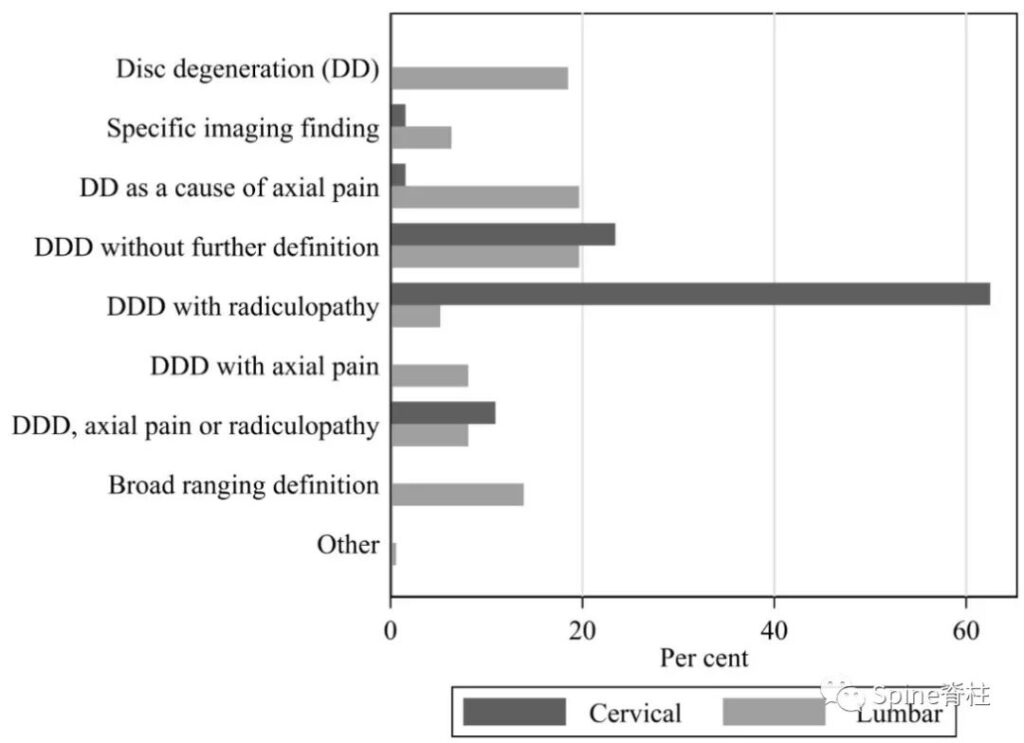
Figure: Read the retrieved full text articles carefully, using different case definitions for all the percentages of cervical and lumbar degenerative disc disease (DDD). The difference was statistically significant.

Table: Classification of definitions used in 402 studies of degenerative disc disease. When the term DDD appears in the title, the specific definition and frequency of DDD.
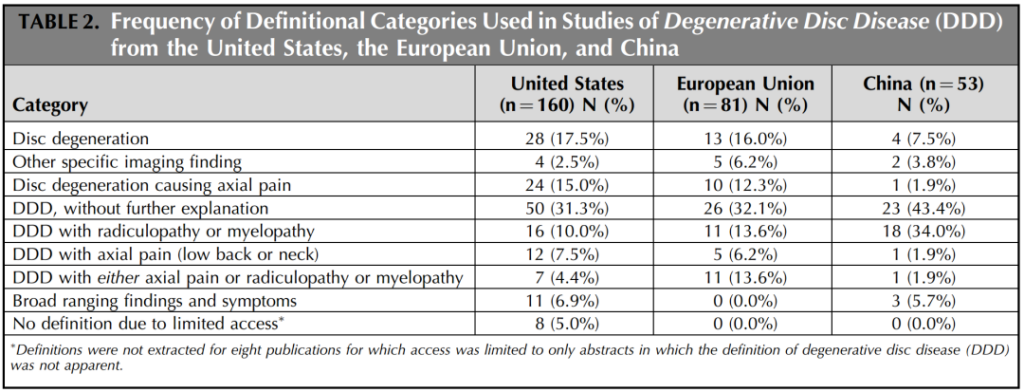
Table: Frequency of definition classification used in studies on degenerative disc diseases from the United States, the European Union and China.
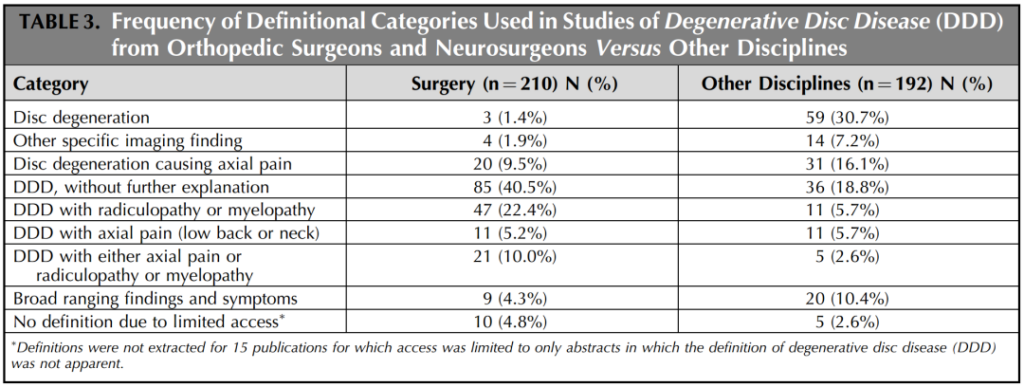
Table: Frequency of definition categories used by orthopedics, neurosurgeons, and scholars in other disciplines in research on degenerative disc disease. The difference between the two groups was statistically significant.
Finally, Professor Battié et al. concluded that degenerative disc diseases (DDD) is still an imperfect concept, its definition is vague, and there are many different opinions. The inconsistency of this definition hinders clear and accurate communication among scholars, easily causes confusion and misunderstanding among clinicians, patients, and others, and hinders the progress of relevant knowledge. It’s time to reconsider the use of the term degenerative disc diseases (DDD).
(sourcechinanet, reference only)
Disclaimer of medicaltrend.org



